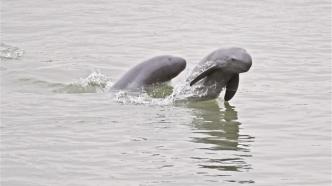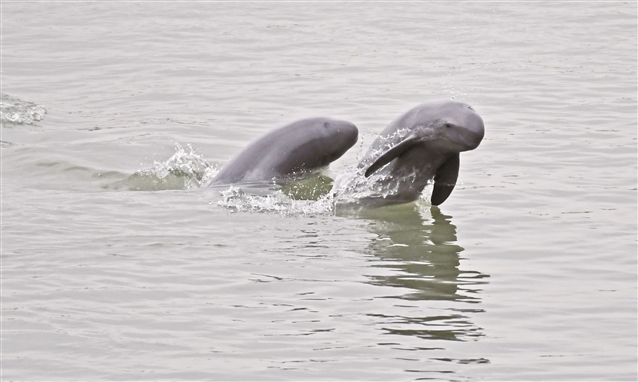


In the lower reaches of Gezhouba in the Yichang section of the Yangtze River, finless porpoises chase and play in the river. Liu Shusong / Photo
On February 28, the Ministry of Agriculture and Rural Affairs announced the results of the 2022 Yangtze finless porpoise scientific research in the entire basin: the current population of the Yangtze finless porpoise is about 1,249, including about 595 in the main stream of the Yangtze River, about 492 in Poyang Lake, and about 162 in Dongting Lake. On March 1, the scientific research team of the Institute of Hydrobiology of the Chinese Academy of Sciences (hereinafter referred to as the Institute of Hydrobiology of the Chinese Academy of Sciences), which is the technical support team for the scientific research of the Yangtze River finless porpoise, introduced to the "Chinese Journal of Science" that this is the first time since the monitoring records that the population of the Yangtze River finless porpoise has been stopped. fall back up.
Yangtze River water is good "dolphin" prophet
Why is the population change of the Yangtze finless porpoise so important? Wang Ding, a researcher at the Institute of Hydrobiology of the Chinese Academy of Sciences and director of the Wuhan Baiji Conservation Foundation, introduced that the Yangtze finless porpoise is a first-class national key protected wild animal and a unique freshwater cetacean in the Yangtze River. The finless porpoise of the Yangtze River is at the top of the food chain of aquatic animals in the entire Yangtze River, and the living conditions of the finless porpoise are the "display" of the quality of the ecological environment of the Yangtze River. It can be said that the water environment of the Yangtze River depends on the number of finless porpoises.
In the past 40 years, the number of finless porpoises in the Yangtze River has declined sharply. In the early 1990s, there were still about 3,600 finless porpoises in the Yangtze River. In 2006, the number dropped sharply to about 1,800. By 2012, there were only about 1,045 finless porpoises left. The statistical results of the three Yangtze River scientific expeditions have all dropped sharply, which has aroused concerns from all walks of life. Many scientists, including Wang Ding, worry that the finless porpoise will follow in the footsteps of the baiji.
In 2007, the baiji was declared "functionally extinct" in the wild. In 2018, the IUCN updated the Red List of Threatened Species, which listed the Yangtze River Baiji as "critically endangered"; on July 21, 2022, it announced the complete extinction of the Yangtze River Baiji. The Yangtze River Baiji is called the "Goddess of the Yangtze River" and the finless porpoise is called the "Smiling Angel". They both live in the Yangtze River Basin and are also endemic to China. "Just a little bit, the finless porpoise followed in the footsteps of the baiji dolphin. Fortunately, it caught up with the good times." Wang Ding said.
The Magic of "The Great Protection of the Yangtze River"
In January 2016, General Secretary Xi Jinping emphasized at the Symposium on Promoting the Development of the Yangtze River Economic Belt that the restoration of the ecological environment of the Yangtze River should be placed in an overwhelming position, and that we should jointly focus on major protection and not engage in large-scale development. "The general secretary's thesis speaks to our hearts." Wang Ding introduced that since 2016, more than ten provinces and cities along the Yangtze River have coordinated pollution control and ecological restoration, and the "Great Protection of the Yangtze River" has brought visible changes.
"2022 is the third time for me to participate in the Yangtze finless porpoise scientific expedition. Compared with the previous two scientific expeditions, we have seen many gratifying changes this time." During the scientific research, he has three intuitive feelings. One is that the water of the Yangtze River has become clearer, the banks have turned green, and the once devastated coastline has now become full of vitality; The 100-kilometer section of the river above Wuhan is a blank area for the distribution of finless porpoises. However, on the first day of the scientific expedition in 2022, scientists observed finless porpoises in the section of the Wuhan River. "The baby finless porpoise was just born in September, and with its mother, the mother and child are particularly obvious. Seeing the mother and child, everyone sees hope. I believe that there will be more and more finless porpoises in the future." Mei Zhigang said.
From over-exploitation of the Yangtze River to "jointly grasping great protection and not engaging in large-scale development", Xi Jinping's ecological civilization thought is profoundly changing the ecological appearance of the Yangtze River, and is also quietly changing the living environment of the Yangtze River finless porpoise. The results of the 2022 Yangtze River Scientific Expedition show that, The number of finless porpoises in the Yangtze River has achieved a historic rebound.
How to keep the "smiling angel"
"1249, this number is encouraging. It proves that the living environment of the finless porpoise has been greatly improved, but the population of the Yangtze finless porpoise is still small, and the status of being critically endangered has not changed. We still face many challenges." Wang Ding said frankly.
Hao Yujiang, an associate researcher at the Institute of Hydrobiology of the Chinese Academy of Sciences, said that currently, the finless porpoise habitat is mainly facing threats such as clear water erosion, disorderly development of river floodplains, shipping development, and waterway regulation. He called for continued adherence to the great protection of the Yangtze River, while at the same time strengthening the infrastructure of the existing ex-situ protected areas, improving management levels, and trying to release finless porpoises in the ex-situ protected areas to the Yangtze River to promote the rapid recovery of natural populations.
Researchers such as Mei Zhigang called for further public participation. He said that in recent years, provinces and cities along the Yangtze River have not only issued relevant laws and regulations on the protection of the Yangtze River and adopted active protection measures, but also established finless porpoise protection associations in many places. During the 2022 Yangtze finless porpoise scientific expedition, the expedition team clearly felt the support of non-government forces from all over the country for the scientific expedition. Many protection organizations spontaneously cooperated and echoed the scientific expedition team to do a lot of work. In the future, increasing publicity and encouraging more people to participate in finless porpoise protection will play a key role in retaining the "smiling angels".
It is gratifying that at present, the relevant state departments and the provinces and cities along the Yangtze River have gradually formed a mechanism for coordinating the management and protection of the Yangtze River. Protecting the finless porpoise, protecting biodiversity, and protecting the ecology of the Yangtze River has become the consensus of most people. In terms of scientific research, the protection of finless porpoise has gradually changed from "unpopular" to "hot". "There are more and more people doing this work now, and professional finless porpoise researchers are no longer marginal and 'endangered' as they used to be," Ding Wang happily told the Chinese Journal of Science.
Reporter's Notes
The return of the finless porpoise is just the beginning
The spring breeze returns to the south bank of the Green River, and the dolphins return with beautiful mountains and clear waters. The historical rise in the number of finless porpoises reflects the ecological improvement brought about by the great protection of the Yangtze River and a profound change in the concept of development.
Focusing only on development and ignoring the environment once led to "Yangtze River Sickness" and baiji dolphins became functionally extinct. The severe challenges faced by the biodiversity of the Yangtze River are in front of us, and the lessons are vivid. From the relocation of the chemical plant along the river, to the thundering sword of the "illegal wharf demolition"; from the embroidery work along the river bank restoration, to the foresight of the "ten-year fishing ban", "together to grasp the great protection, not to engage in large-scale development" The final word of the policy brings about changes in ideological understanding, changes in development concepts, and changes in ecological quality, which are of great and far-reaching significance.
It should also be noted that in some places there are voices such as "it is worthwhile to spare no effort to protect the environment", "we need to eat more than the ecology", "it is okay to protect the ecology, but we can't go too far". It must be made clear that the great protection of the Yangtze River has just begun and is in the ascendant, far from reaching the ideal state. Ecological damage is easy, but restoration is difficult. It cannot be accomplished overnight.
The gratifying achievement of "historical decline in the number of finless porpoises" is a strong proof of the scientific nature of the great protection of the Yangtze River; the grim reality of "the status of being extremely endangered has not changed" is a profound reminder to continue to further promote the great protection of the Yangtze River. "Putting the restoration of the ecological environment of the Yangtze River in an overwhelming position" is the long-term policy of the country. Continue to maintain the strategic focus of "the current and a long period of time in the future", do not be disturbed by noise, don't take the beginning too far, and go one by one. It can realize the harmonious coexistence of man and the Yangtze River, and make the "smiling angel" live forever. (Original title "The number of "smiling angels" has stopped falling and rebounded historically, experts said: the critically endangered status of the Yangtze finless porpoise has not changed")